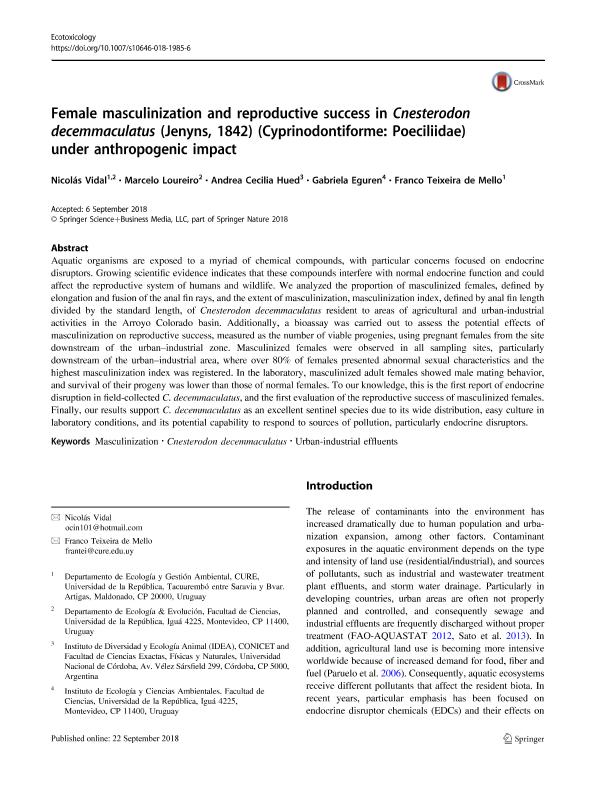Mostrar el registro sencillo del ítem
dc.contributor.author
Vidal, Nicolás
dc.contributor.author
Loureiro, Marcelo
dc.contributor.author
Hued, Andrea Cecilia

dc.contributor.author
Eguren, Gabriela
dc.contributor.author
Teixeira de Mello, Franco

dc.date.available
2019-11-27T16:42:00Z
dc.date.issued
2018-12-22
dc.identifier.citation
Vidal, Nicolás; Loureiro, Marcelo; Hued, Andrea Cecilia; Eguren, Gabriela; Teixeira de Mello, Franco; Female masculinization and reproductive success in Cnesterodon decemmaculatus (Jenyns, 1842) (Cyprinodontiforme: Poeciliidae) under anthropogenic impact; Springer; Ecotoxicology; 27; 10; 22-12-2018; 1331–1340
dc.identifier.issn
0963-9292
dc.identifier.uri
http://hdl.handle.net/11336/90654
dc.description.abstract
Aquatic organisms are exposed to a myriad of chemical compounds, with particular concerns focused on endocrine disruptors. Growing scientific evidence indicates that these compounds interfere with normal endocrine function and could affect the reproductive system of humans and wildlife. We analyzed the proportion of masculinized females, defined by elongation and fusion of the anal fin rays, and the extent of masculinization, masculinization index, defined by anal fin length divided by the standard length, of Cnesterodon decemmaculatus resident to areas of agricultural and urban-industrial activities in the Arroyo Colorado basin. Additionally, a bioassay was carried out to assess the potential effects of masculinization on reproductive success, measured as the number of viable progenies, using pregnant females from the site downstream of the urban–industrial zone. Masculinized females were observed in all sampling sites, particularly downstream of the urban–industrial area, where over 80% of females presented abnormal sexual characteristics and the highest masculinization index was registered. In the laboratory, masculinized adult females showed male mating behavior, and survival of their progeny was lower than those of normal females. To our knowledge, this is the first report of endocrine disruption in field-collected C. decemmaculatus, and the first evaluation of the reproductive success of masculinized females. Finally, our results support C. decemmaculatus as an excellent sentinel species due to its wide distribution, easy culture in laboratory conditions, and its potential capability to respond to sources of pollution, particularly endocrine disruptors.
dc.format
application/pdf
dc.language.iso
eng
dc.publisher
Springer

dc.rights
info:eu-repo/semantics/openAccess
dc.rights.uri
https://creativecommons.org/licenses/by-nc-sa/2.5/ar/
dc.subject
CNESTERODON DECEMMACULATUS
dc.subject
MASCULINIZATION
dc.subject
URBAN-INDUSTRIAL EFFLUENTS
dc.subject.classification
Otros Tópicos Biológicos

dc.subject.classification
Ciencias Biológicas

dc.subject.classification
CIENCIAS NATURALES Y EXACTAS

dc.title
Female masculinization and reproductive success in Cnesterodon decemmaculatus (Jenyns, 1842) (Cyprinodontiforme: Poeciliidae) under anthropogenic impact
dc.type
info:eu-repo/semantics/article
dc.type
info:ar-repo/semantics/artículo
dc.type
info:eu-repo/semantics/publishedVersion
dc.date.updated
2019-10-16T14:30:57Z
dc.identifier.eissn
1573-3017
dc.journal.volume
27
dc.journal.number
10
dc.journal.pagination
1331–1340
dc.journal.pais
Alemania

dc.description.fil
Fil: Vidal, Nicolás. Universidad de la República; Uruguay
dc.description.fil
Fil: Loureiro, Marcelo. Universidad de la República; Uruguay
dc.description.fil
Fil: Hued, Andrea Cecilia. Consejo Nacional de Investigaciones Científicas y Técnicas. Centro Científico Tecnológico Conicet - Córdoba. Instituto de Diversidad y Ecología Animal. Universidad Nacional de Córdoba. Facultad de Ciencias Exactas Físicas y Naturales. Instituto de Diversidad y Ecología Animal; Argentina
dc.description.fil
Fil: Eguren, Gabriela. Universidad de la República; Uruguay
dc.description.fil
Fil: Teixeira de Mello, Franco. Universidad de la República; Uruguay
dc.journal.title
Ecotoxicology

dc.relation.alternativeid
info:eu-repo/semantics/altIdentifier/doi/http://dx.doi.org/10.1007/s10646-018-1985-6
dc.relation.alternativeid
info:eu-repo/semantics/altIdentifier/url/https://link.springer.com/article/10.1007%2Fs10646-018-1985-6
Archivos asociados
